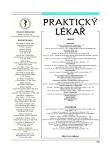The aggressive patient
Agresivní pacient
Sdělení se zabývá problematikou agresivního chování pacienta vůči lékaři. Je zaměřeno na tři základní okruhy: poznatky o zdrojích agresivního chování a průběhu napadení; rozeznávání varovných signálů; přehled základních zvládajících komunikačních postupů.
Současně jsou zde prezentovány názory studentů všeobecného lékařství Lékařské fakulty Univerzity Palackého v Olomouci. Podle názorů studentů 3. ročníku pacient od lékaře očekává zejména odbornost a komunikační dovednosti. U studentů 5. ročníku převažuje názor, že lékař má podporovat srozumitelnou, vstřícnou a pozitivní komunikaci vůči agresivnímu pacientovi.
Klíčová slova:
agrese – agresivní pacient – napadení.
Authors:
J. Králová
Authors‘ workplace:
Ústav sociálního lékařství a zdravotní politiky LF UP, Olomouc
přednosta prof. MUDr. I. Gladkij, CSc.
Published in:
Prakt. Lék. 2005; 85(4): 230-232
Category:
General Medicine
Overview
The paper deals with problems of the aggressive behavior of the patient towards the attending physician. It is focused on three basic areas: pieces of knowledge on the sources of aggressive behavior and the course of assault; the recognizing of warning signs; a review of the basic communicative managing procedures. Simultaneously there are presented the views of students at the Faculty of General Medicine, Palacký University in Olomouc. According to the opinion of third-year students, the patient expects of the physician namely professionality and communicative abilities. Among fifth-year students the prevailing opinion is that the physician should sustain an intelligible, accomodative and positive communication towards the aggressive patient.
Key words:
aggression – aggressive patient – assault.
Labels
General practitioner for children and adolescents General practitioner for adultsArticle was published in
General Practitioner

2005 Issue 4
- Metamizole vs. Tramadol in Postoperative Analgesia
- Memantine in Dementia Therapy – Current Findings and Possible Future Applications
- Metamizole at a Glance and in Practice – Effective Non-Opioid Analgesic for All Ages
- What Effect Can Be Expected from Limosilactobacillus reuteri in Mucositis and Peri-Implantitis?
- Hope Awakens with Early Diagnosis of Parkinson's Disease Based on Skin Odor
Most read in this issue
- The aggressive patient
- Benign cutaneous pigmented lesions and the various possibilities in their examination
- Musculoskeletal complaints at work with the computer
- Genetics and ethics – past, present, and future
